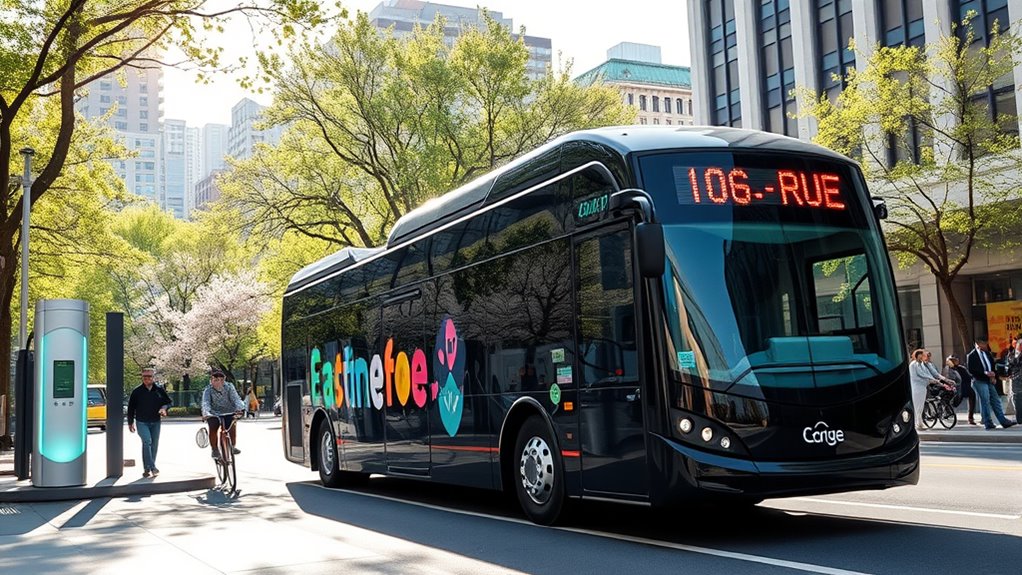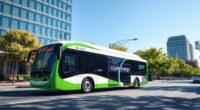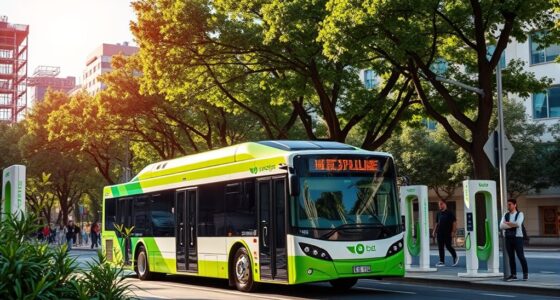Electric buses greatly lower environmental impacts throughout their lifecycle by producing zero tailpipe emissions, especially when powered by renewable energy, and offering higher efficiency. While manufacturing, especially battery production, demands more resources and energy, advances like recycling and better materials are reducing these effects. During operation, they cut pollution and noise, saving costs in fuel and maintenance. To discover how innovations and regional efforts boost their sustainability, keep exploring these solutions further.
Key Takeaways
- Electric buses produce zero tailpipe emissions during operation, significantly reducing local air pollution and greenhouse gases compared to diesel buses.
- Battery manufacturing involves high resource use and energy, contributing to higher lifecycle emissions, though advancements aim to reduce this impact.
- Recycling and circular economy practices mitigate environmental impacts by recovering materials and reducing waste over the vehicle’s lifespan.
- Operating costs are lower due to cheaper electricity and reduced maintenance, enhancing economic sustainability and overall lifecycle benefits.
- Regional energy sources and infrastructure influence total environmental impact, with renewable energy integration improving sustainability outcomes.
Overview of Lifecycle Environmental Considerations

Understanding the lifecycle environmental considerations of electric buses is essential for evaluating their true sustainability. During operation, they produce zero tailpipe emissions, eliminating local pollutants like NOx and particulate matter, and markedly reducing noise pollution. Their environmental impact depends heavily on the energy mix; if powered by renewable sources, they can achieve near net-zero emissions, while fossil-fuel-heavy grids reduce their benefits. Over their lifespan, electric buses emit about 181 metric tonnes less CO₂ than diesel buses. They also consume less energy thanks to regenerative braking, which cuts overall energy use. Additionally, advancements in solar energy solutions can further enhance the sustainability of electric bus fleets by providing cleaner electricity for charging stations. Proper management of battery recycling is crucial to mitigating environmental concerns associated with battery disposal and ensuring sustainable use of resources. Implementing life cycle assessments helps identify areas for environmental improvements throughout the electric bus lifecycle. Moreover, ongoing research into battery technology aims to improve energy density and reduce environmental impacts associated with battery manufacturing and disposal.
Environmental Impact During Manufacturing

Manufacturing electric buses involves higher resource demands compared to conventional models, primarily due to the complex processes required to produce batteries and specialized drivetrain components. Battery production requires rare earth metals like lithium, cobalt, and nickel, often extracted through energy-intensive mining, raising sustainability and geopolitical concerns.
This stage accounts for the largest share of manufacturing emissions, with battery manufacturing contributing 30-70%. The assembly process consumes more energy because of high-temperature production of cells, specialized facilities, and lightweight materials like aluminum, which also demand significant energy.
Globalized sourcing increases transportation emissions and raises risks of toxic waste and water contamination. Although manufacturing emissions are 20-50% higher than diesel buses, innovations like recycling, renewable energy, and advanced battery tech aim to mitigate these impacts.
Benefits During Operation and Usage
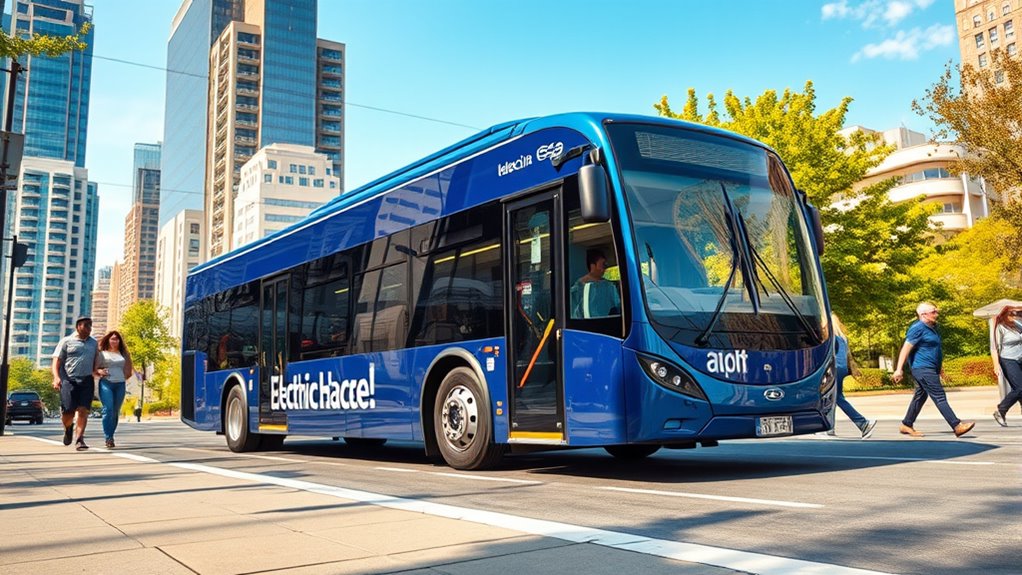
Electric buses offer significant environmental and societal benefits during their operation and daily use. They produce no tailpipe emissions, dramatically improving local air quality and reducing respiratory issues. Each electric bus saves about 181 metric tonnes of CO2 annually compared to diesel counterparts, helping cut greenhouse gases.
Their quieter operation reduces noise pollution, creating a calmer urban environment and enhancing passenger comfort. Electric buses also consume less energy due to their high-efficiency electric motors, which convert 60-70% of electrical energy into motion, surpassing diesel engines. Matters of comfort and support Additionally, the use of eco-friendly materials in manufacturing can further minimize their environmental footprint. Incorporating sustainable materials in their design can help reduce the overall ecological impact of their lifecycle. This transition to electric buses supports environmental sustainability by lowering the reliance on fossil fuels and promoting cleaner energy sources.
This shift decreases dependence on fossil fuels, especially if powered by renewable energy sources. Additionally, electric buses are more reliable and require less maintenance, lowering operational costs.
Economic and Long-term Sustainability Gains
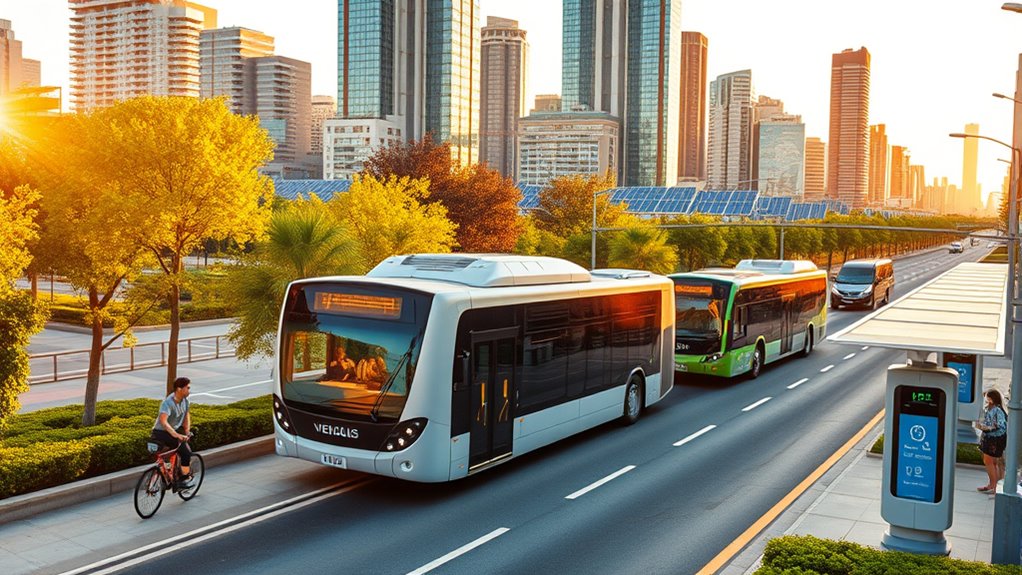
Switching to electric buses offers substantial long-term economic and sustainability benefits by considerably reducing ongoing operational costs and fostering local economic growth. Because electricity is about 2.5 times cheaper than diesel, you’ll save notably on fuel expenses, with lifetime savings reaching up to $400,000 per bus.
Electric buses also require less maintenance due to fewer moving parts, lowering costs over time. Although the initial investment in charging infrastructure is higher, government incentives help offset costs and create local jobs. Cost savings from reduced maintenance further enhance the financial appeal of electric buses.
Stable electricity prices reduce budget uncertainty, and local energy production supports community growth. Additionally, electric buses enhance energy efficiency, cut pollution, and decrease greenhouse gas emissions, contributing to long-term environmental and economic resilience for your transit system. Incorporating renewable energy sources can further amplify these environmental benefits. Moreover, advances in battery technology continue to improve the range and charging times, making electric buses an even more practical choice for transit authorities.
Comparing Electric Buses to Other Vehicle Types
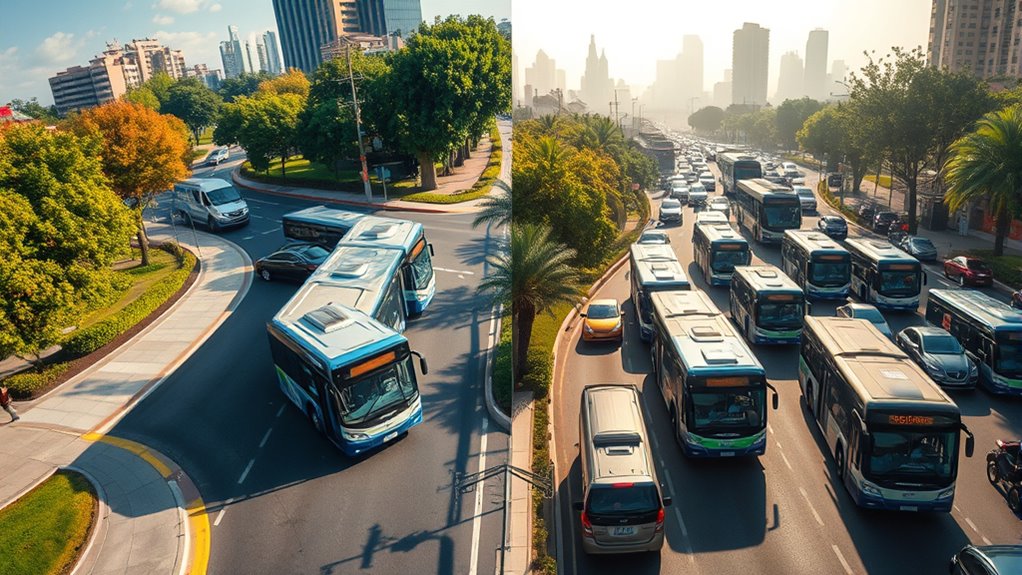
When comparing electric buses to other vehicle types, their environmental and operational advantages become clear. Electric buses produce markedly lower lifecycle greenhouse gas emissions than diesel and propane models, emitting 181 fewer metric tonnes of CO2 per bus. They consume less energy annually, reducing reliance on fossil fuels and lowering overall carbon footprints during operation. Moreover, their ability to operate with renewable energy sources enhances their sustainability profile even further. Additionally, electric buses drastically cut local air pollution and noise, improving urban air quality and public health—preventing thousands of premature deaths. They also require less maintenance, leading to operational cost savings and increased durability. While traditional vehicles depend heavily on fossil fuels, electric buses can operate near zero emissions when charged with renewable energy. These benefits make electric buses a cleaner, more efficient alternative across diverse vehicle types. Considering the full lifecycle impact, the cost and budgeting involved in deploying electric buses can be significantly lower over time, especially with advancements in battery technology and renewable energy integration.
Overcoming Challenges and Future Opportunities

Although electric buses offer significant environmental benefits, their widespread adoption faces several production challenges. Manufacturing batteries consumes substantial resources and energy, especially since raw materials like lithium and cobalt are limited and raise environmental and ethical concerns. Improving recyclability is crucial to reduce waste and reliance on primary materials. Nutritional value of juices can serve as an analogy for optimizing resource use and waste reduction in battery recycling processes. Additionally, integrating sustainable manufacturing practices can further lower the environmental footprint of battery production. Innovations in recycling technology can also help recover valuable materials efficiently and sustainably. Technological advancements, such as higher energy density batteries, promise to cut production emissions, lower costs, and boost performance. Shifting to renewable energy sources for manufacturing can further enhance environmental benefits, but regions dependent on fossil fuels see limited gains. Developing infrastructure for renewable energy and recycling systems, combined with innovations in battery technology, presents opportunities to overcome current hurdles. Emphasizing circular economy practices will be key to reducing waste and promoting reuse throughout the lifecycle of electric bus batteries. Public-private collaboration and circular economy practices will be key to making electric buses more sustainable and accessible worldwide.
Frequently Asked Questions
How Do Battery Recycling Processes Affect Overall Environmental Impact?
You might wonder how battery recycling affects the environment. Recycling conserves resources by reducing the need for mining, saving energy, and cutting waste. It also minimizes landfills and environmental hazards.
While high costs and technological challenges exist, advancements can boost efficiency. By supporting recycling, you help promote a circular economy, reduce pollution, and extend battery life.
Ultimately, these efforts make electric transportation more sustainable and environmentally friendly.
What Are the Social Implications of Resource Extraction for Batteries?
Imagine communities near mining sites, their land scarred and water sources strained. You see families displaced, health risks rising, and indigenous lands under threat.
Resource extraction for batteries often hits vulnerable communities hardest, creating environmental and social tensions.
You recognize this process can deepen inequality, causing harm that lasts generations, unless we prioritize fair practices and sustainable alternatives to guarantee everyone benefits from cleaner transportation.
How Does Vehicle Lifespan Influence Lifecycle Environmental Benefits?
Your question about vehicle lifespan and environmental benefits highlights how extending an electric bus’s life can improve its ecological footprint. When you increase the lifespan from 10 to 20 years, you spread out manufacturing impacts and reduce the frequency of replacements, lowering overall emissions.
However, you should also consider maintenance needs, as longer use might require more repairs. Overall, longer vehicle lifespans generally enhance environmental benefits by maximizing the use of cleaner energy over time.
What Policies Encourage Sustainable Battery Supply Chains?
Imagine building a house on a solid foundation; policies shape that base. You encourage transparency and traceability with digital records, ensuring responsible mining.
Adopting third-party certifications and enforcing due diligence audits act like sturdy beams.
Incentives for recycling, battery passports, and international standards serve as the walls and roof, safeguarding a sustainable supply chain.
Together, these policies create a resilient, eco-friendly framework for sourcing batteries responsibly.
How Do Electric Buses Impact Urban Noise Pollution Levels Long-Term?
You see, electric buses markedly lower urban noise pollution over time by operating quieter than diesel buses. Their lack of loud engines reduces daytime noise levels, creating more peaceful city environments.
As more electric buses replace traditional ones, the overall noise decreases, improving residents’ health and quality of life. Long-term, this shift fosters tranquil, sustainable urban spaces, benefiting communities by reducing stress and noise-related health issues.
Conclusion
By understanding the full lifecycle impact of electric buses, you realize they’re not just a greener choice but a smarter investment for the future. While challenges remain, the benefits during operation and long-term sustainability far outweigh the initial hurdles. Remember, you can’t judge a book by its cover—diving deeper shows electric buses offer significant environmental and economic gains. Embracing this technology puts you ahead of the curve, paving the way for cleaner, more sustainable transit systems.
